Mysterious Mummy of Gue Monastery Spiti Valley
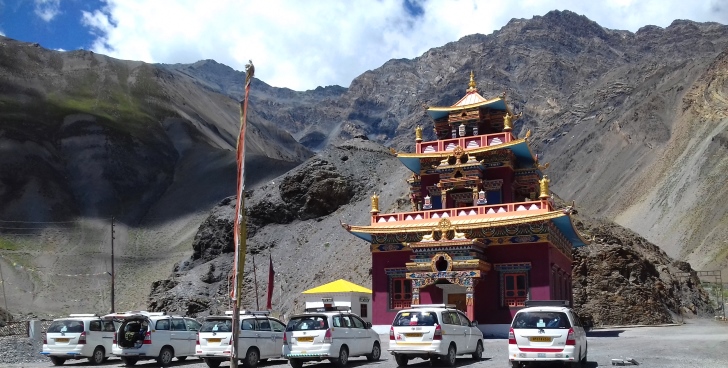
Spiti Valley, where for centuries people lived largely isolated from one another, holding and preserving the treasures and secrets of ancient civilizations untainted by modernity unmatched outside these impressive mountains. Explore India's Naturally Preserved Mummy — "The Mysterious Mummy of Gue Monastery in Spiti Valley", which attracts travellers, artists, explorers and researchers from all over the world. Natural mummification is rare, requiring conditions of extreme temperatures and dry air to preserve the body. They mummified most mummies from Egypt that we see today with a chemical process called embalming and then wrapped in linen, but the Mummy in Spiti Valley is a lot different from Egyptian Mummies. Below article will help you know, how….?
Sangha Tenzin, A Buddhist Monk "Mummy in Gue Monastery"
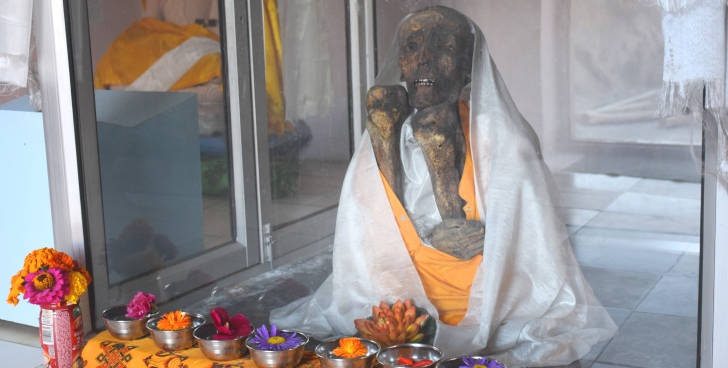
Close to India's border with China, Gue village Monastery in Spiti valley is famous for its naturally preserved mummy of a Buddhist monk Sangha Tenzin. The 15th century old, mummified body of this Buddhist monk, Sangha Tenzin, is in a sitting meditation pose and d the cold, harsh weather of Spiti valley has helped in its natural preservation. The Mummy of Gue village is almost 600 years old, now kept in a glass box, inside a small room next to the Gue Monastery Spiti Valley. Clearly you can see the teeth, hairs and the well-preserved skin on the bones of the Mummy of Gue in the Spiti Valley of Indian Himalayas. Researchers have found only 24 Self Mummification bodies around the World, till date.
Secret Mummy in India – Gue Village and The Mummy
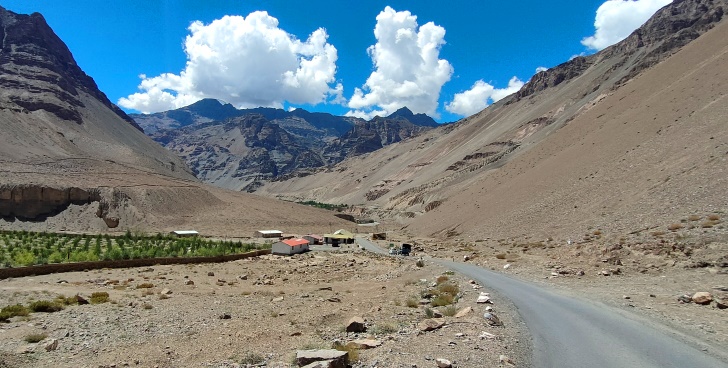
Due to border security reasons and remoteness of Gue village, the existence of the Mummy of Gue Village remained as a secret under wraps for years and years. The desolation wilderness area of Spiti was out of the reach for tourism for decades and even the locals were not aware of this Secret Mummy of India. Here in Gue village, the Mummy was discovered from a stupa after the earthquake in 1975 only, while the Indo-Tibet Border Force was clearing the area and building the road and bunkers.
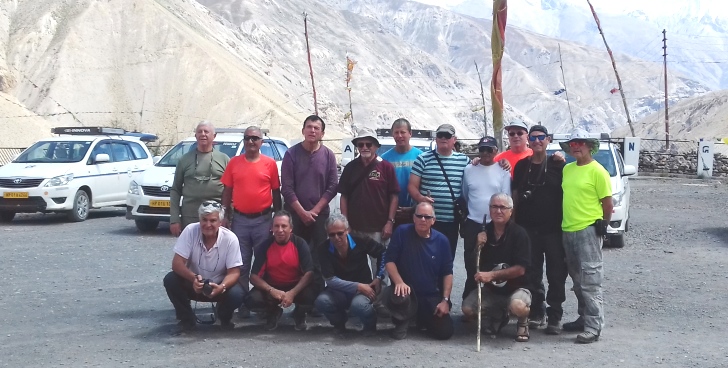
In 2002 the team of researchers from Oxford University of California, came here for Research on this Secret Mummy in India, with the carbon Dating, they found that Sangha Tenzin the "Gue Village Mummy" has been in the same sitting posture since 1430 A.D and they mentioned "That Its Naturally Preserved and Nothing Is Used to Preservation of The Body". This can happen when a dead body is exposed to extreme cold, dry conditions, or some other environmental factor that mollifies against decay.
Story of Gue Village Mummy - Follows Ancient Tradition of self mummification
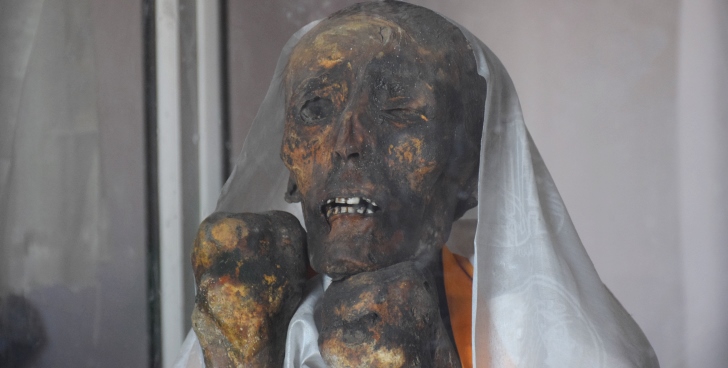
As per the practices, during the 11th Century to 19 Century in the process of gaining enlightenment, the Buddhist Monks were practising the mummification process on themselves. "Sokushinbutsu" the term for self-mummification, refers to the practice of Buddhist monks, putting wilfully themselves to death, through starvation and meditation while still being alive.
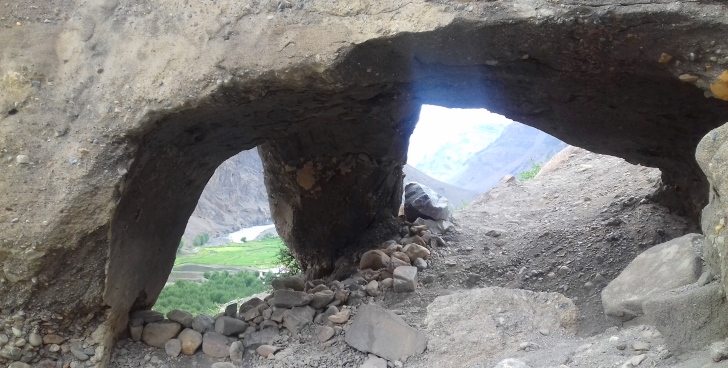
As, per the ancient practices, the monks used to sit and mediate inside the caves and follow a special diet with meditation. To reduce the fats in the body, they were not taking any kind of food, which includes fats. The Self mummification process would come towards by the end of their life, which might take several months up to a decade. During this process through meditation and continuous fasting the monks aimed themselves to bring their body in a condition where after their death, no bacteria's will survive in their body and the natural harsh and cold weather of the valley, will help them to naturally preserve and mummified their body, in which only a few will succeed.
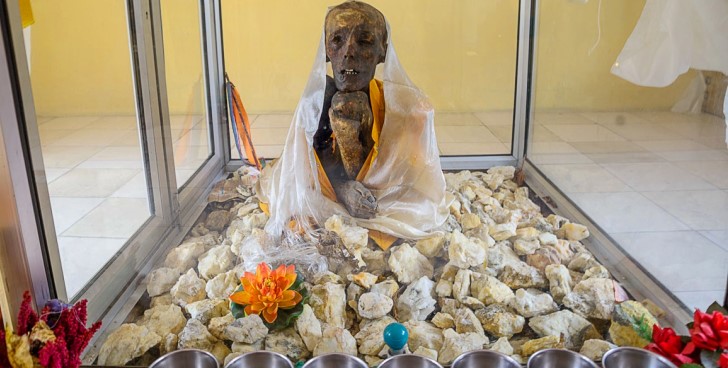
As they were not drinking any type of fluids or taking food, their bodies were becoming thin and internal organs were already shrinking, so the body could not decompose- thus preserving the physical form and beginning the process of Natural Mummification. Its excellent state is probably due to the dry air, low humidity and extremely cold climate of the surrounded high-altitude cold desert, which is the secret behind the natural preservation of The Mummy of Gue in India.
The Folklore–Another Story of Gue Village Mummy in Spiti Valley
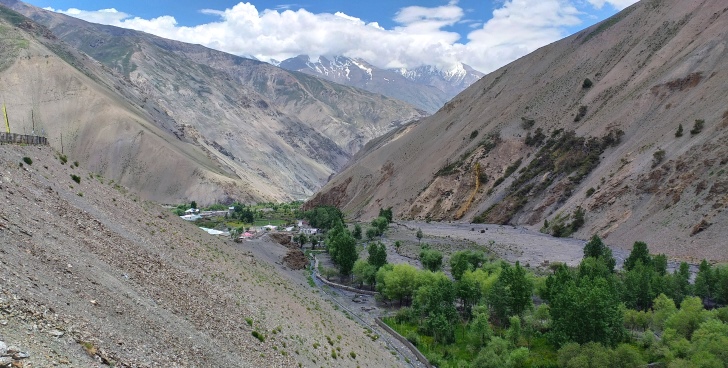
In the ancient times, Gue village was on the important trade route between Tibet to Ladakh and Zanskar via Spiti. As a result, the village prospered the folk tales that passed through generations by words of mouth, and the locals tell this with pride and devotion. As per the folk story, they believe that the mummy of Gue has been looking after the well-being of their village for centuries now…! Shifting the Mummy brings bad luck, floods and natural disaster into the village. The story, as per the folklore that the monk now the Mummy of Gue sacrificed his life to rid the village of the menace of scorpions. Villagers believe that after the death of many people in the village, the monk became concerned and sat in meditation for the betterment of the villagers, and asked his disciples to entomb him. They mentioned that as monks' soul left for heaven, a rainbow appeared across the blue sky, and it ended the scorpion epidemic.
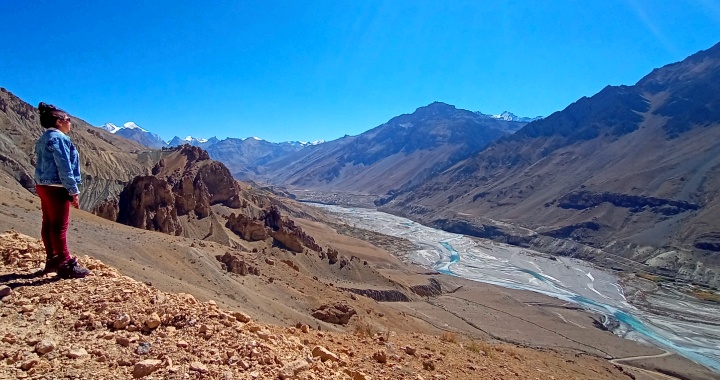
The local villagers also believe that the mummy is alive, and claim that the hair and nails of the monk are still growing. The villagers hold the mummy of Gue in great esteem and worship it like their protector. They offered prayers daily to the Mummy of Gue Monastery, wherein they burn incense and light butter lamps.
Mummy In Spiti Valley Added Attraction to Visitors
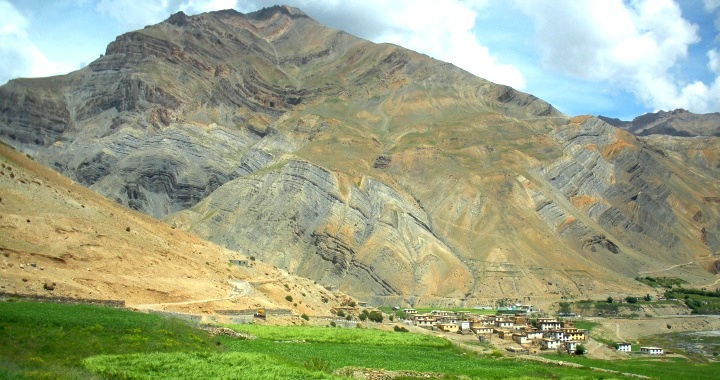
If it was not the Mummy of Gue, this village has remained unknown to the world- but the discovery of the Mummy of Gue in Spiti valley has proven to attract more travellers to the destination. With each passing year, Spiti valley is looking a rise in tourism as travellers have the opportunity to discover this Secret Mummy of India. This mummy has put the small village of Gue on the global map, providing new opportunities for the locals in the form of home stays and establishing small cafes.
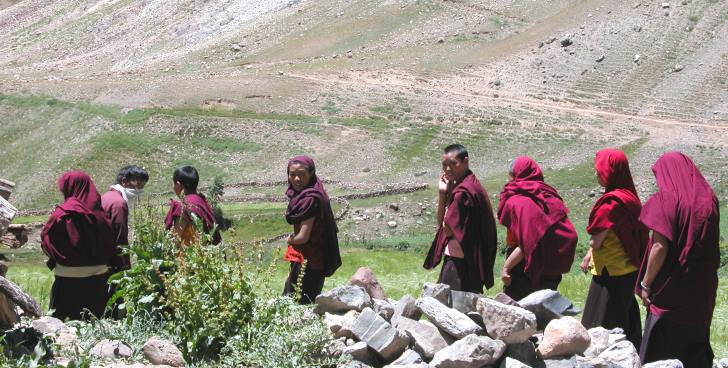
It's almost three decades now, when I visited the Mummy of Gue in Spiti valley for the first time. The Mummy was kept open, inside a small room, on a nearby hilltop, next to the Indo Tibet Police Force camp. We need to prove our identity and a local village or someone from the ITBP camp will come with us with the keys to open the doors of that room and then only we were able to visit and see the Secret Gue village mummy. The mummy was kept open in a room and I was told that people try to stealing the hairs of the Mummy and taking with them as a blessing to keep in their home.
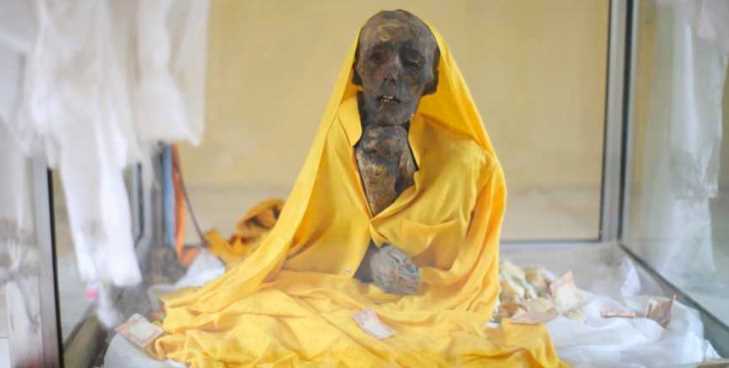
Sometimes back to protect and preserve the Secret Mummy of India, they have made a new room next to the monastery of Gue, where the mummified body has kept now, in a glass box. The work of the new Gue monastery is under progress and recently the village society collects entrance ticket of 30 /- Rupees per person to visit the Mummy of Gue in the monastery, which is being spent in the development of the Gue monastery and the nearby area.
How To Reach Gue Village Mummy
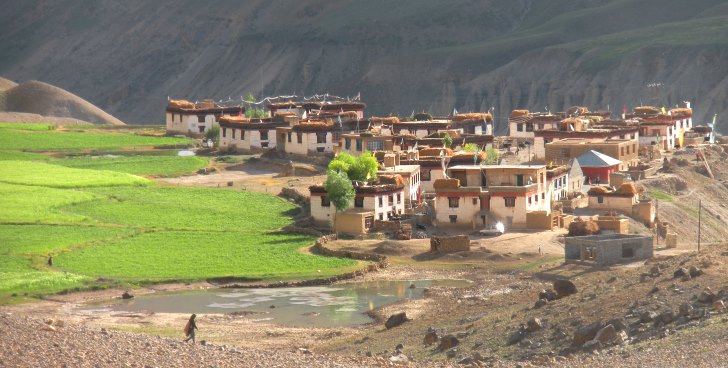
At an altitude of 3,280 metres/ 10,790 feet, Gue village has 40-50 traditional mud houses. On the NH 05, as soon as you enter Spiti at Sumdo Check post from Shimla side and drive to Tabo- just after 3 kilometres further from Sumdo, you take a right turn from Gue Nahla, into a gorge leading approx. 8 kms., to the village of Gue also spelled Giu. The approximate road distance from Shimla to Gue is 350 kms., Sumdo Check post to Gue 11 kms, the famous Tabo Monastery 35 kms, Kaza to Gue distance 80 kms. You can explore the Gue Monastery Mummy in a few hours the day you travel from Kalpa/Nako to Tabo/ Kaza, where you find good home stays and hotels to stay in.
Best Time to visit Gue Monastery
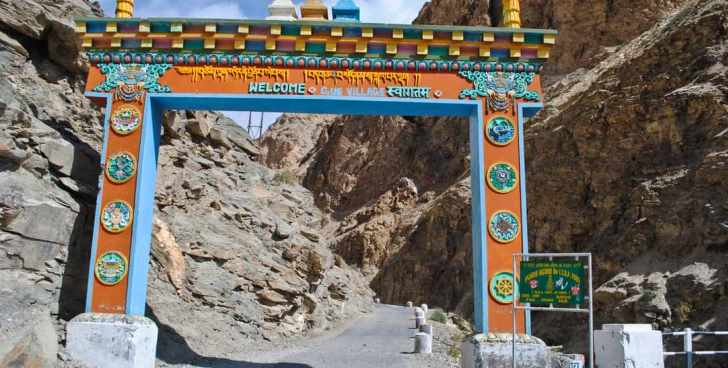
The road from Shimla to Spiti via Rampur-Tapri-Nako -Tabo - KAZA remains opens almost throughout the year winters expect a couple of days in winters when it really snows heavily. The Gue village might not be approachable from Mid-December to March end due to icy roads, landslides or snow making the climb difficult to the village. During April to November is the best time to visit Gue Monastery. Please keep in mind if it's raining, skip the tour to Mummy of Gue as the rolling stones or landslides can block the way in or out to the village, interrupting your tour.
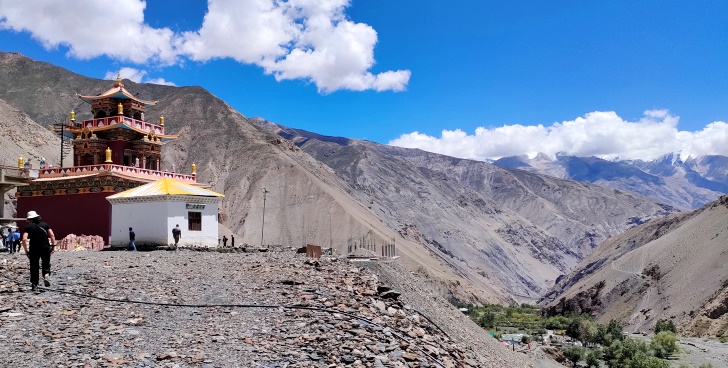
The monastery provides amazing mountain views, plan your Spiti Valley Tour and explore these Hidden Gems and Secret places of Spiti valley in India. Spiti Trips "Tours by Locals" the best travel agent to Spiti Valley which provides great offers, best deals and customises the Spiti Valley tour as per your requirements, interests and available time. You can contact through WhatsApp +919805051102, Email: info@summitsafari.com






